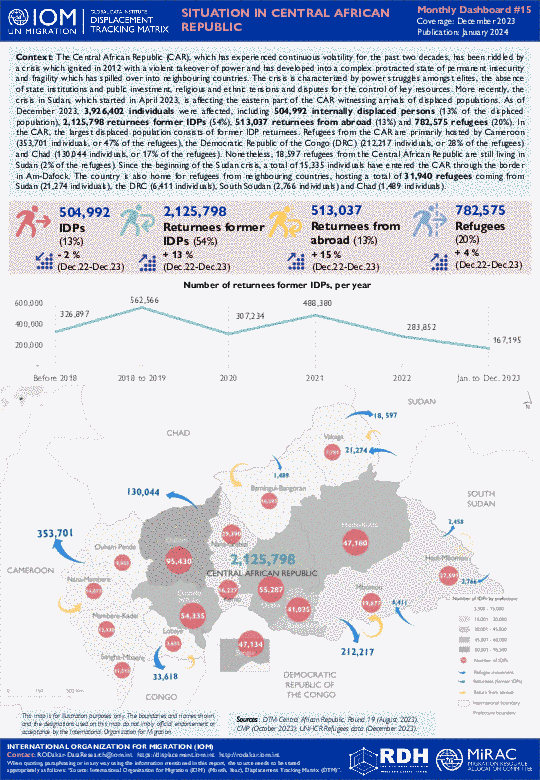-
Countries
-
Data and Analysis
-
Special Focus
-
Crisis Responses
The Central African Republic (CAR), which has experienced continuous volatility for the past two decades, has been riddled by a crisis which ignited in 2012 with a violent takeover of power and has developed into a complex protracted state of permanent insecurity and fragility which has spilled over into neighbouring countries. The crisis is characterized by power struggles amongst elites, the absence of state institutions and public investment, religious and ethnic tensions and disputes for the control of key resources. More recently, the crisis in Sudan, which started in April 2023, is affecting the eastern part of the CAR witnessing arrivals of displaced populations.
As of December 2023, 3,926,402 individuals were affected, including 504,992 internally displaced persons (13% of the displaced population), 2,125,798 returnees former IDPs (54%), 513,037 returnees from abroad (13%) and 782,575 refugees (20%). In the CAR, the largest displaced population consists of former IDP returnees. Refugees from the CAR are primarily hosted by Cameroon (353,701 individuals, or 47% of the refugees), the Democratic Republic of the Congo (DRC) (212,217 individuals, or 28% of the refugees) and Chad (130,044 individuals, or 17% of the refugees).
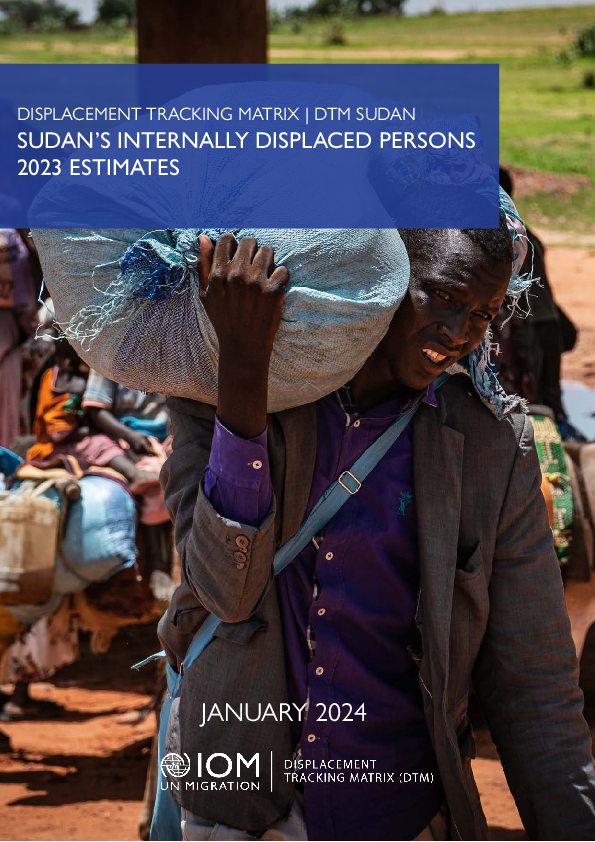
Contact
DTM Sudan, DTMSudan@iom.int
Language
English
Location
Sudan
Snapshot Date
Dec 31 2023
Activity
- Mobility Tracking
- Baseline Assessment
Overview
The displacement crisis in Sudan has been unfolding for over two decades, with roots in the Darfur conflict beginning in 2003. However, the current conflict between the Sudanese Armed Forces (SAF) and the Rapid Support Forces (RSF) has drastically reshaped displacement dynamics across Sudan since 15 April 2023.
Armed clashes in multiple cities across Sudan have displaced an estimated 6,036,176 IDPs over the past nine months. Prior to 15 April 2023, Sudan already hosted as estimated 3,820,772 IDPs.
To estimate the overall number of IDPs in Sudan, including both those displaced before and after 15 April 2023, DTM Sudan carried out extensive analysis of its displacement data which is presented in this report. The methodology used accounts for secondary displacement to estimate the baseline figure for the total number of IDPs in Sudan to inform humanitarian partners.
Sudan hosts an estimated 9,052,822 internally displaced persons (IDPs) as of 31 December 2023, representing the largest internal displacement crisis worldwide.
Highlights
-
9,052,822 Displaced Individuals
-
1,806,602 Displaced Households
-
7,211 Locations
-
19% Living in Informal Settlements
-
2,199,478 Children Under 5
Contact
dtmlebanon@iom.int
Location
Lebanon
Activity
- Mobility Tracking
- Baseline Assessment
Period Covered
Oct 10 2023 -Jan 16 2024
Since October 8 there has been an increase in cross-border incidents between Israel and Lebanon, resulting in the displacement of people both within the South and elsewhere within the country. Since October 10, the Displacement Tracking Matrix (DTM) has been conducting the daily monitoring of population movements. The objective of the exercise is to inform preparedness and response planning.
Population Groups
IDPs
Survey Methodology
Unit of Analysis Or Observation
Admin Area 2
Admin Area 3
Household
Individual
Type of Survey or Assessment
Key Informant
Keywords
Geographical Scope Full Coverage
Administrative boundaries with available data
The current dataset covers the following administrative boundaries
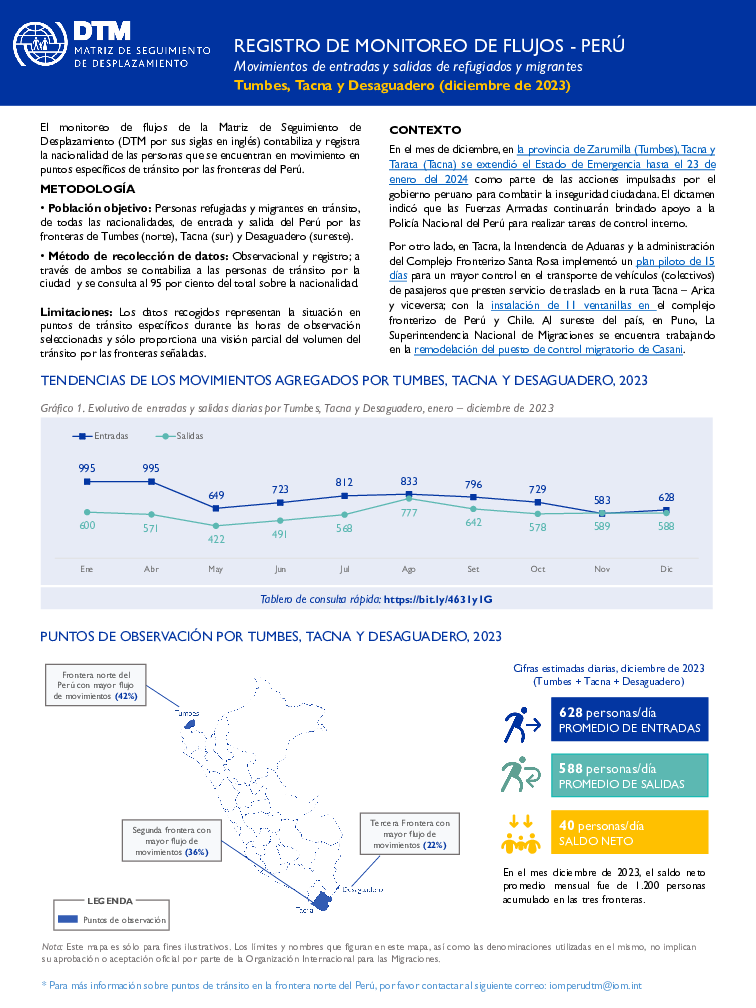
Contact
DTM Peru, IOMDTMPeru@iom.int
Language
English
Location
Peru
Period Covered
Dec 01 2023
Dec 31 2023
Activity
- Flow Monitoring
En diciembre de 2023, las fronteras de Perú experimentaron cambios significativos. A lo largo del mes, se implementaron medidas para combatir la inseguridad ciudadana en Zarumilla (Tumbes), Tacna y Tarata (Tacna), extendiendo el Estado de Emergencia hasta el 23 de enero de 2024. Las Fuerzas Armadas continuaron apoyando a la Policía Nacional del Perú en tareas de control interno. En Tacna, se ejecutó un plan piloto de 15 días en el Complejo Fronterizo Santa Rosa para mejorar el control del transporte de vehículos de pasajeros en la ruta Tacna – Arica. Se instalaron 11 ventanillas para facilitar este proceso en el complejo fronterizo de Perú y Chile. En Puno, al sureste, la Superintendencia Nacional de Migraciones trabajó en la remodelación del puesto de control migratorio de Casani.

Contact
DTM Pakistan, DTMPakistan@iom.int
Language
English
Location
Pakistan
Period Covered
Oct 01 2023
Dec 31 2023
Activity
- Flow Monitoring
The International Organization for Migration (IOM) in Pakistan collects data on the outflows of Afghans at the Torkham (Khyber Pakhtunkhwa) and Chaman (Balochistan) border crossing points (BCPs) to better understand the movements of Afghans returning to Afghanistan. The data presented below is harmonised with those from the United Nations High Commissioner for Refugees (UNHCR), who also cover Ghulam Khan (Khyber Pakhtunkhwa), Badini and Bahramcha (Balochistan).
On 26 September 2023, the Ministry of Interior in Pakistan announced its decision to enact its “Illegal Foreigners’ Repatriation Plan (IFRP)”. Since 1 January 2023, IOM identified 557,436 returns at the five BCPs. Eighty-four per cent (467,919) of the annual returns have occurred in the last quarter of 2023 when the IFRP was enacted.
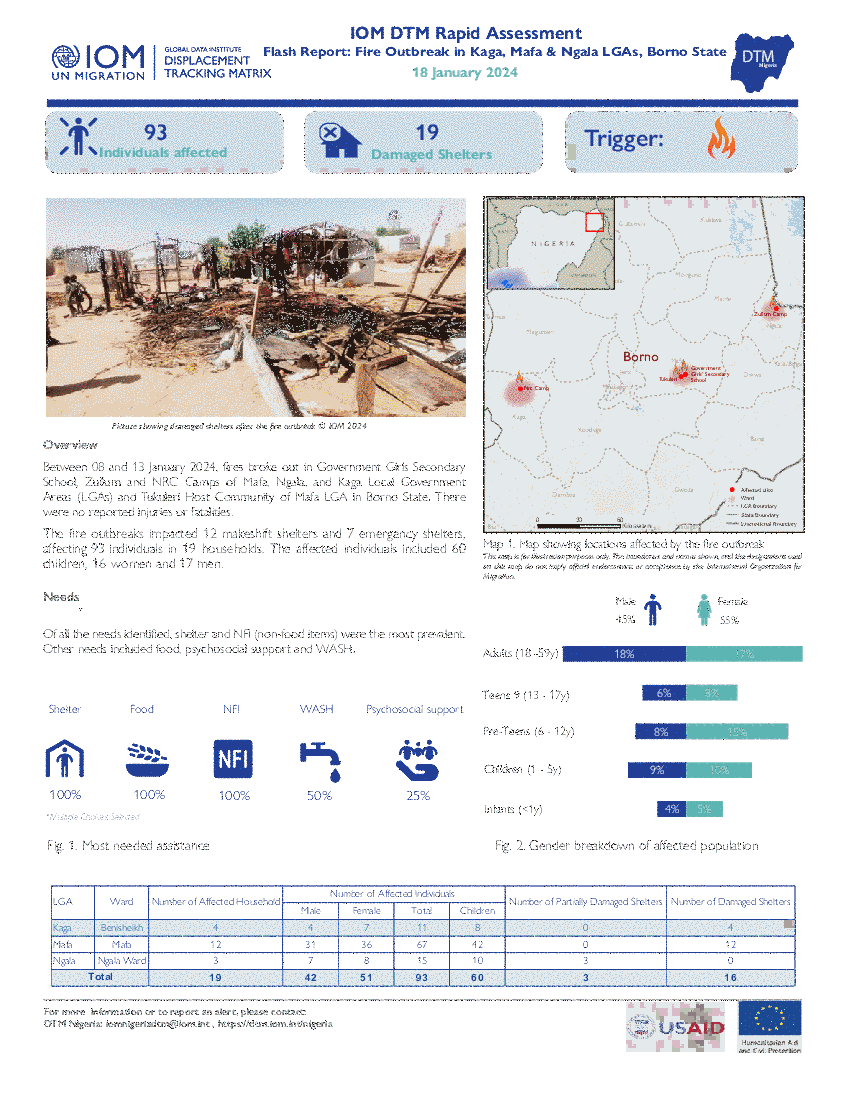
Contact
DTM Nigeria, AllUsersInDTMNigeria@iom.int
Language
English
Location
Nigeria
Period Covered
Jan 08 2024
Jan 13 2024
Activity
- Mobility Tracking
- Event Tracking
Between 08 and 13 January 2024, fires broke out in Government Girls Secondary School, Zullum and NRC Camps of Mafa, Ngala, and Kaga Local Government Areas (LGAs) and Tukuleri Host Community of Mafa LGA in Borno State. There were no reported injuries or fatalities.
The fire outbreaks impacted 12 makeshift shelters and 7 emergency shelters, affecting 93 individuals in 19 households. The affected individuals included 60 children, 16 women and 17 men.
Contact
DTM Yemen, iomyemendtm@iom.int
Location
Yemen
Activity
- Mobility Tracking
- Event Tracking
Period Covered
Jan 14 2024 -Jan 20 2024
From 1 January to 20 January 2024, IOM Yemen DTM tracked 194 households (HH) (1,164 Individuals) who experienced displacement at least once.
Between 14 and 20 January 2024, IOM Yemen DTM tracked 52 households (312 individuals) displaced at least once. The majority of people moved into/within the following governorates and districts:
- Ma’rib (36 HHs) – Marib City (18 HHs), Marib (11 HHs), Harib (7 HHs) districts. Most displacements in the governorate originated from Marib and Al Hodeidah.
- Al Hodeidah (8 HHs) – Al Khukhah (7 HHs), Hays (1 HH) districts. Most displacements in the governorate originated from Taiz and Al Hodeidah.
- Ta’iz (5 HHs) – Al Makha (5 HHs) district. Most displacements in the governorate were internal.
The majority of people moved from the following governorates and districts:
- Al Hodeidah Ta’iz (12 HHs) – Al Hali (2 HHs), Jabal Ras (2 HHs), Hays (2 HHs) districts.
- Ta’iz (12 HHs) – Maqbanah (6 HHs), At Taiziyah (3 HHs), Sharab As Salam (1 HH) districts.
- Ma’rib (10 HHs) – Harib (9 HHs), Raghwan (1 HH) districts.
Population Groups
Survey Methodology
Unit of Analysis Or Observation
Type of Survey or Assessment
Keywords
Geographical Scope
Administrative boundaries with available data
The current dataset covers the following administrative boundaries
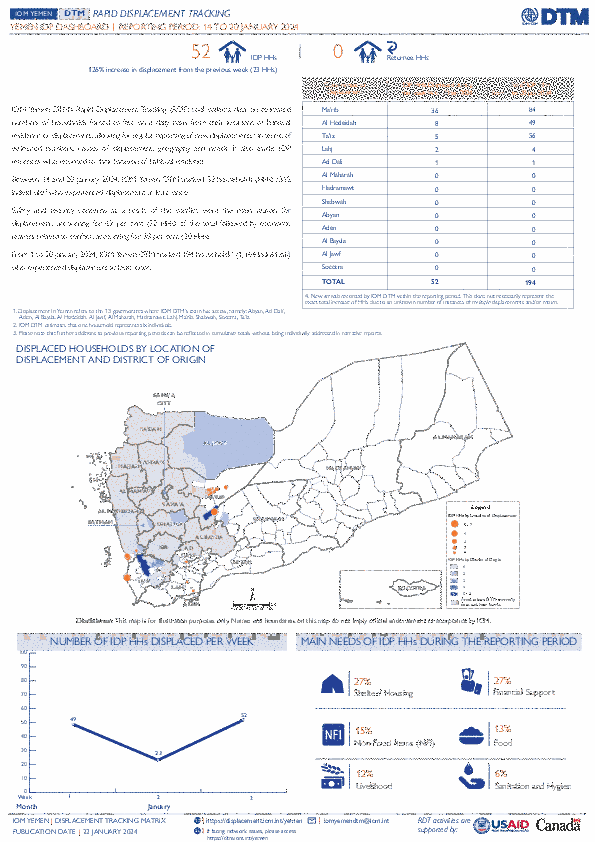
Contact
DTM Yemen, iomyemendtm@iom.int
Language
English
Location
Yemen
Period Covered
Jan 14 2024
Jan 20 2024
Activity
- Mobility Tracking
- Event Tracking
IOM Yemen DTM’s Rapid Displacement Tracking (RDT) tool collects data on estimated numbers of households forced to flee on a daily basis from their locations of origin or displacement, allowing for regular reporting of new displacements in terms of estimated numbers, geography, and needs. It also tracks returnees who returned to their location of origin.
From 1 January to 20 January 2024, IOM Yemen DTM tracked 194 households (HH) (1,164 Individuals) who experienced displacement at least once.
Between 14 and 20 January 2024, IOM Yemen DTM tracked 52 households (312 individuals) displaced at least once. The majority of people moved into/within the following governorates and districts:
- Ma’rib (36 HHs) – Marib City (18 HHs), Marib (11 HHs), Harib (7 HHs) districts. Most displacements in the governorate originated from Marib and Al Hodeidah.
- Al Hodeidah (8 HHs) – Al Khukhah (7 HHs), Hays (1 HH) districts. Most displacements in the governorate originated from Taiz and Al Hodeidah.
- Ta’iz (5 HHs) – Al Makha (5 HHs) district. Most displacements in the governorate were internal.
The majority of people moved from the following governorates and districts:
- Al Hodeidah Ta’iz (12 HHs) – Al Hali (2 HHs), Jabal Ras (2 HHs), Hays (2 HHs) districts.
- Ta’iz (12 HHs) – Maqbanah (6 HHs), At Taiziyah (3 HHs), Sharab As Salam (1 HH) districts.
- Ma’rib (10 HHs) – Harib (9 HHs), Raghwan (1 HH) districts.
IOM identified 72 households displaced in the previous reporting period, which covered 07 - 13 January 2024, in the governorates of . These figures have been added to the cumulative displacement total recorded since the beginning of the year.
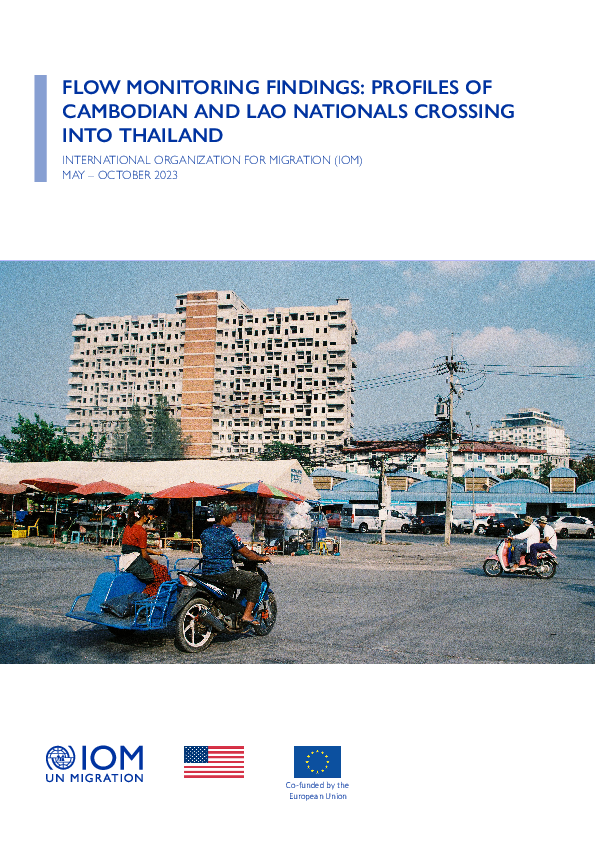
Contact
DTM Thailand, dtmthailand@iom.int
Language
English
Location
Thailand
Period Covered
May 01 2023
Oct 31 2023
Activity
- Survey
- Flow Monitoring Survey
- Flow Monitoring
To gain a better understanding of the mobility dynamics and vulnerabilities of Cambodian and Lao nationals entering Thailand, IOM Thailand initiated flow monitoring activities at key points of entry (POEs) in Bueng Kan, Chanthaburi, Loei, Nong Khai, and Sa Kaeo provinces between May and October 2023 using IOM Displacement Tracking Matrix (DTM) tools. Flow monitoring is designed to track the scale and characteristics of human mobility along the border, including the volume, intended destinations, reasons for movement, intended lengths of stay, and expectations about work sectors and conditions. The activity provides critical insights into current mobility dynamics on the Eastern borders with Cambodia and Lao People’s Democratic Republic.
FMC and FMS are conducted simultaneously at each point for one week every month. Chanthaburi, Loei, Nong Khai, and Sa Kaeo were chosen due to pre-existing information indicating that the four provinces experience a substantial volume of entries.

Contact
DTM-OSE: dtmvzaresponse@iom.int
Language
Spanish
Location
Panama
Period Covered
Aug 01 2023
Aug 31 2023
Activity
- Flow Monitoring Survey
- Flow Monitoring
La provincia del Darién se ubica en la frontera este de Panamá, y su territorio forma parte de las rutas migratorias más utilizadas por personas en situación de movilidad humana por las Américas para migrar desde el sur hacia el norte del continente. A su vez, esta ruta es altamente peligrosa por las características geográficas del Parque Nacional Darién y la presencia de crimen organizado. Las personas que la transitan se encuentran expuestas a riesgos varios como la trata de personas, tráfico ilícito, violencia basada en género, diversas formas de explotación y abuso. El uso de estas rutas inseguras para llegar a destinos temporarios o finales plantea amenazas para la integridad, dignidad y la vida de las personas migrantes.
Entre el 01 y el 31 de agosto de 2023 se registraron 81.946 personas migrantes ingresando irregularmente por la provincia Darién, suponiendo un promedio de 2.643 migrantes ingresando diariamente. Entre los meses de enero y agosto de 2023 ingresaron 333.704 personas, una cifra más de tres veces superior a la registrada en las mismas fechas del 2022 (103.378).
